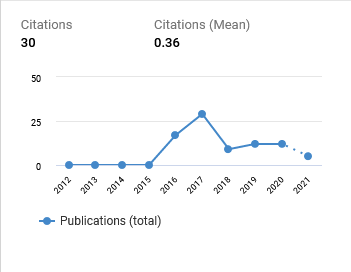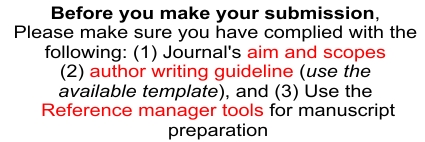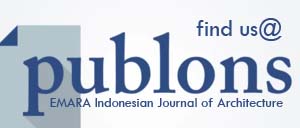Simulasi Desain Fasad Optimal Terhadap Pencahayaan Alami Pada Gedung Prodi Arsitektur Universitas Malikussaleh
DOI:
https://doi.org/10.29080/emara.v4i1.228Keywords:
Pencahayaan Alami, Desain Fasad, Permodelan Berbasis Data Cuaca, Useful Daylight IlluminanceAbstract
The department of architecture’s building of Malikussaleh University was found problematic with its daylighting distribution through out the spaces. Also, earlier research had acknowledged the situation. However, the previous research did not offer an appropriate solution particularly regarding its optimum façade design. This research attempted to optimize the daylight harvest into the spaces by comparing its façade design for daylighting. There were three types of façade designs, perforated, vertical and horizontal screens, examined fot its most optimum daylight harvest. This study utilized digital simulation using Grasshopper and Ladybug Tools to calculate Annual daylight condition within the building. Within the tools this study integrated Climate Based Daylight Modeling (CBDM), which was Useful Daylight Illuminance (UDI) for the condition of Lhokseumawe. Next, it compared and suggested the result for the three types of façade design for optimum daylight distribution. Based on UDI, the targetted optimum daylight was in the range of 100-2000 lux. It was discovered that horizontal screen work best to almost entire building façades which covered 13 out of 15 examined-spaces within the building.
Downloads
References
Ander, G. D. (2016). Daylighting. Retrieved July 1, 2018, from https://www.wbdg.org/resources/daylighting
Anderson, K. (2014). Design Energy Simulation for Architects. New York: Routledge.
Atthaillah, Iqbal, M., & Situmeang, I. S. (2017). Simulasi Pencahayaan Alami Pada Gedung Program Studi Arsitektur Universitas Malikussaleh. NALARs, 16(2), 113–124.
Elghazi, Y., Wagdy, A., Mohamed, S., & Hassan, A. (2014). Daylighting Driven Design : Optimizing Kaleidocycle Facade For Hot Arid Climate. In German-Austrian IBPSA Conference. https://doi.org/10.13140/RG.2.1.3198.4408
Erlendsson, Ö. (2014). Daylight Optimization: A Parametric Study of Atrium Design. Royal Institute of Technology Stockholm. Retrieved from http://www.diva-portal.org/smash/get/diva2:723644/FULLTEXT01.pdf
Groad, L., & Wang, D. (2013). Architectural Research Method (2nd ed.). Canada: John Wiley & Sons, Inc.
Holst, R. (2013). Think, Script, Build. Technical University of Denmark, Denmark.
Mardaljevic, J. (2010). Climate-Based Daylight Analysis for Residential Buildings Impact of various window configurations , external obstructions , orientations and location on useful daylight illuminance. Leicester.
Moreno, M. B. P., & Labarca, C. Y. (2015). Methodology for assessing daylighting design strategies in classroom with a climate-based method. Sustainability (Switzerland), 7(1), 880–897. https://doi.org/10.3390/su7010880
Nabil, A., & Mardaljevic, J. (2005). Useful daylight illuminances: a new paradigm for assessing daylight in building. Lighting Research and Technology. https://doi.org/10.1191/1365782805li128oa
Nurhaiza, & Lisa, N. P. (2016). Optimalisasi Pencahayaan Alami pada Ruang. ARSITEKNO, 7(7), 33–41.
Rahimzadeh, S. D. (2015). Use of parametric modelling and climate - based metrics for the efficient design of daylight strategies in buildings with complex geometries. School of Design Queensland University of Technology.
Roudsari, M. S., & Pak, M. (2013). Ladybug: A Parametric Environmental Plugin For Grasshopper to Help Designers Create An Environmentally-Conscious Design. In 13th Conference of International Building Performance Simulation Association (pp. 3128–3135). Chambery.

Downloads
Published
How to Cite
Issue
Section
Categories
License
- Authors retain copyright and grant the journal right of first publication with the work simultaneously licensed under a Creative Commons Attribution ShareAlike License that allows others to share the work with an acknowledgment of the work's authorship and initial publication in this journal.
- Authors are able to enter into separate, additional contractual arrangements for the non-exclusive distribution of the journal's published version of the work (e.g., post it to an institutional repository or publish it in a book), with an acknowledgment of its initial publication in this journal.
- Authors are permitted and encouraged to post their work online (e.g., in institutional repositories, pre-print sites, or on their website) prior to and during the submission process, as it can lead to productive exchanges, as well as earlier and greater dissemination of published work.
































